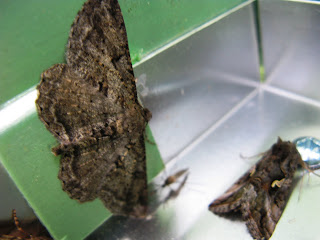This blog may help people explore some of the 'hidden' issues involved in certain media treatments of environmental and scientific issues. Using personal digital images, it's also intended to emphasise seasonal (and other) changes in natural history of the Swansea (South Wales) area. The material should help participants in field-based modules and people generally interested in the natural world. The views are wholly those of the author.
Sunday, 1 August 2010
Nightlife
I got to 'play' last night with a small moth trap in the garden at Loughor. It worked quite well overnight as I caught a Pale grass eggar (Lasiocampa trifolii f flava), a battered Large yellow underwing (Noctua pronuba), several Buff footman (Eilema depressa), a couple of spotted Yponomeuta cagnagella, several Beautiful golden Y (Autographa pulchrina), a possible Iron prominent (Notodonta dromedarius), a July highflier (Hydriomena furcata) and a Lime speck pug (Eupithecia centaureata). Nice to see them all flit off in the morning!
Subscribe to:
Post Comments (Atom)
-
I n the UK and US, a pparently popular and successful vegan/vegetarian restaurants are reportedly closing or adding meat to their menus ( ...
-
Early ripening fruit may seem convenient but some folk think it confirms environmental stress. There's also a possibility th...










%20mating%20NWCW.jpg)


No comments:
Post a Comment